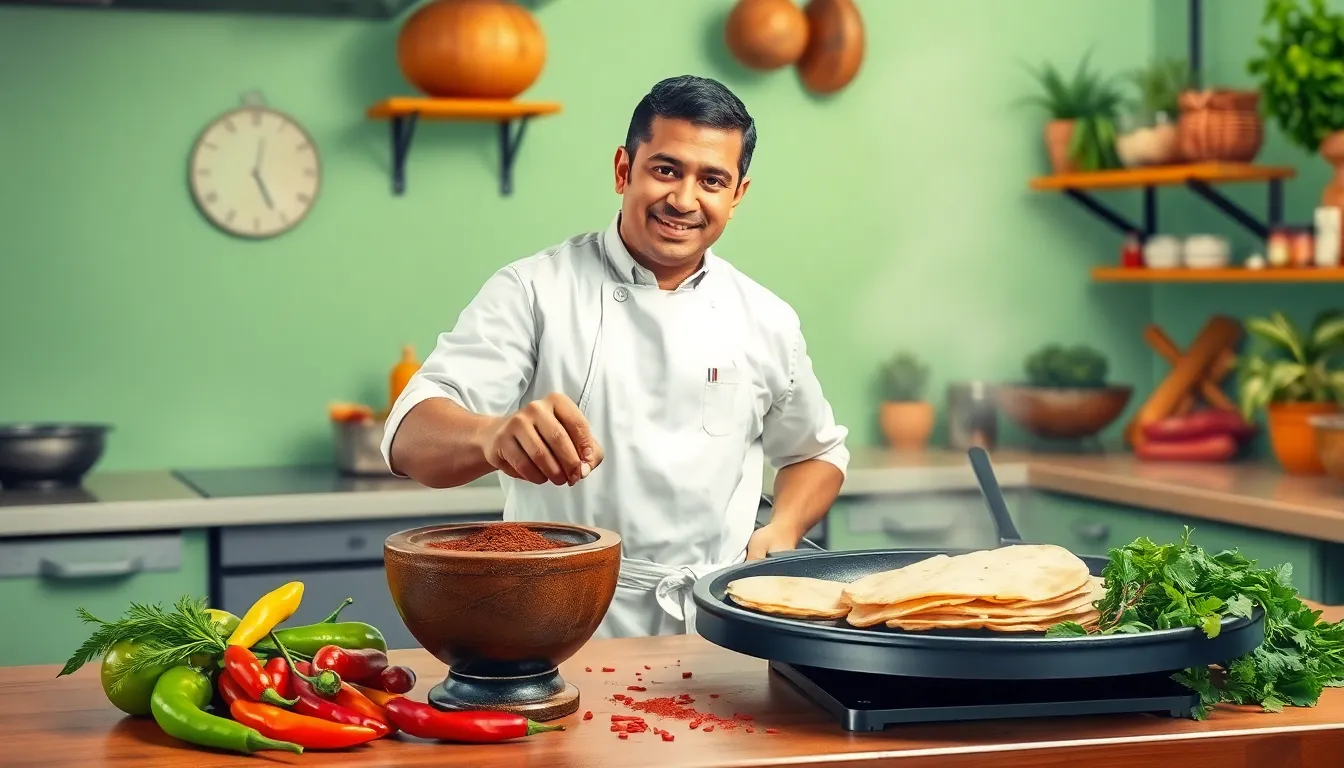Mexican cooking isn’t just about tacos and guacamole—it’s a vibrant tapestry of techniques that transform simple ingredients into culinary masterpieces. Picture this: a sizzling comal, the aroma of roasted chiles, and the rhythmic sound of a molcajete grinding spices. These techniques are the secret sauce behind every unforgettable fiesta.
Table of Contents
ToggleOverview Of Mexican Cooking Techniques
Mexican cooking techniques showcase a tradition steeped in history, utilizing methods that enhance flavors and preserve cultural identity. Cooking on a comal, a flat griddle primarily made from clay or cast iron, provides a unique way to prepare tortillas and other flatbreads. Roasting chiles over an open flame brings out their smokiness, a characteristic flavor crucial in many dishes.
Using a molcajete, a traditional stone mortar and pestle, allows for the grinding of spices and herbs. This technique ensures that essential oils remain intact, significantly enhancing the taste of salsas and sauces. Simmering ingredients slowly in pots or cazuelas helps to meld flavors, creating depth in stews and soups.
Steaming food in a vessel called a tamalera facilitates the preparation of tamales, infusing them with moisture and flavor. Braising meats in rich sauces or adobos often results in tender, flavorful dishes. Techniques like these highlight the emphasis on slow cooking, providing time for flavors to develop and intensify.
Frying, often done in lard or oil, adds a distinct crunch to dishes such as churros and quesadillas. Grilling meats and vegetables over direct heat imparts a smoky flavor, making them irresistible. Incorporating these traditional methods communicates the passion behind Mexican cuisine, creating dishes that resonate with authenticity and cultural significance.
Embracing diverse techniques, Mexican cooking transforms simple ingredients into extraordinary meals, inviting everyone to experience its richness and variety.
Traditional Cooking Methods

Mexican cuisine showcases traditional cooking methods that bring vibrant flavors to life. These techniques, deeply rooted in history, enhance every meal.
Cooking On A Comal
A comal serves as a griddle for cooking tortillas and other flatbreads. Cooking tortillas on a hot comal results in a unique, slightly smoky flavor. Certain cooks also utilize it for toasting spices like cumin or coriander. This technique unlocks richer flavors and aromas, elevating dishes to new heights. Hand-pressed tortillas gain a characteristic texture when cooked on a comal. Using cast iron or clay versions adds authenticity to the cooking process. Heating a comal properly ensures even cooking, making it an essential tool in many kitchens.
Using A Mortar And Pestle
A molcajete, or mortar and pestle, is pivotal for grinding spices and making salsas. Crushing ingredients in a molcajete releases essential oils, enhancing flavor. Fresh garlic, herbs, and chiles find their best expressions when ground together. This method allows for a coarse texture, which differs from mechanical grinders. Traditional recipes showcase how a molcajete captures the essence of every ingredient. Preparing guacamole in one connects the cook to centuries of culinary tradition. Mastery of this technique transforms simple ingredients into complex flavor profiles.
Flavor Development Techniques
Flavor development techniques in Mexican cooking enhance the depth and complexity of dishes. Searing and browning bring out the inherent richness of ingredients through high-heat cooking.
Searing And Browning
Searing involves cooking ingredients like meats over high heat, leading to a caramelized crust that intensifies flavor. This technique creates a Maillard reaction, which provides a savory depth in dishes such as carne asada. Browning aromatics, like onions and garlic, also enriches the overall taste of soups and sauces, contributing layers of flavor. Ingredients showcase a balance between texture and taste, enhancing the culinary experience with each bite. Achieving proper searing techniques elevates both everyday meals and celebratory dishes.
Slow Cooking Methods
Slow cooking techniques, like braising and simmering, allow flavors to marry and develop over time. Cazuelas or Dutch ovens are commonly used to tenderize meats while infusing them with spices and aromatics. This method works well for dishes like mole, where complexity unfolds through long, gentle cooking. Stews and soups benefit from the gradual infusion of flavors, resulting in a comforting and rich profile. Simmering leads to a tender texture as vegetables break down and meld with the broth. Slow cooking celebrates the essence of Mexican cuisine by showcasing the harmony of flavors in every dish.
Contemporary Mexican Cooking Techniques
Contemporary Mexican cooking techniques blend tradition with innovation, creating an exciting culinary landscape.
Sous Vide Cooking
Sous vide cooking allows for precise temperature control and even cooking. Ingredients, such as meats and vegetables, are sealed in vacuum bags and immersed in water for extended periods. This method enhances flavors while retaining moisture, resulting in tender and juicy dishes. Popular uses include cooking carne asada or preparing delicate fish fillets. By utilizing sous vide, chefs elevate traditional recipes while experimenting with textures and presentations.
Fusion Techniques
Fusion techniques in contemporary Mexican cooking combine elements from various global cuisines. Chefs often incorporate ingredients like Asian spices or Mediterranean herbs, creating unique dishes that surprise palates. Tacos filled with Korean beef or enchiladas featuring Thai peanut sauce exemplify this trend. These innovative approaches not only showcase culinary creativity but also reflect cultural exchange. Fusion techniques invite diners to explore new flavors while celebrating the essence of Mexican cuisine.
Mexican cooking techniques embody a rich tapestry of flavors and traditions. Each method not only enhances the taste of dishes but also preserves the cultural heritage that defines this vibrant cuisine. From the smoky allure of a comal to the meticulous grinding of spices in a molcajete, these practices invite culinary exploration and creativity.
As chefs continue to innovate while respecting tradition, the fusion of classic and contemporary techniques offers endless possibilities. This dynamic evolution ensures that Mexican cuisine remains a beloved and celebrated aspect of global gastronomy, inviting everyone to experience its depth and diversity. Embracing these techniques allows for a deeper appreciation of the artistry behind every meal.




